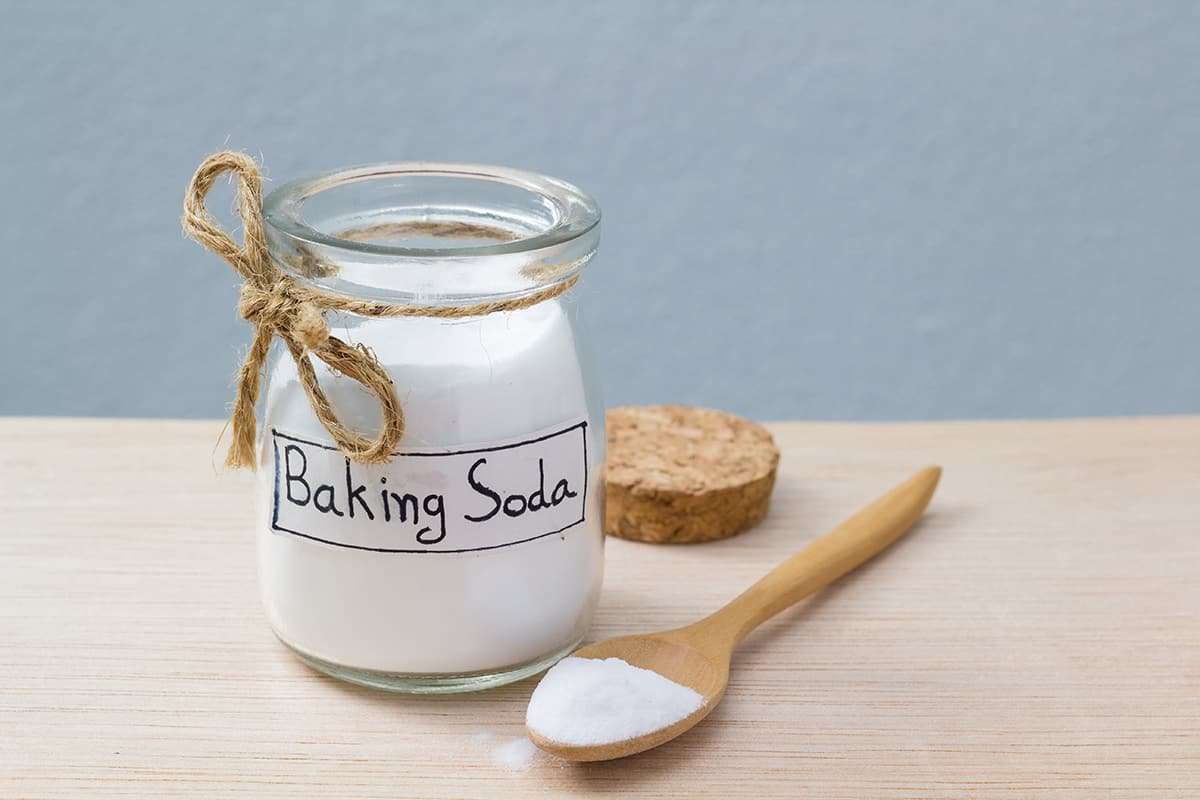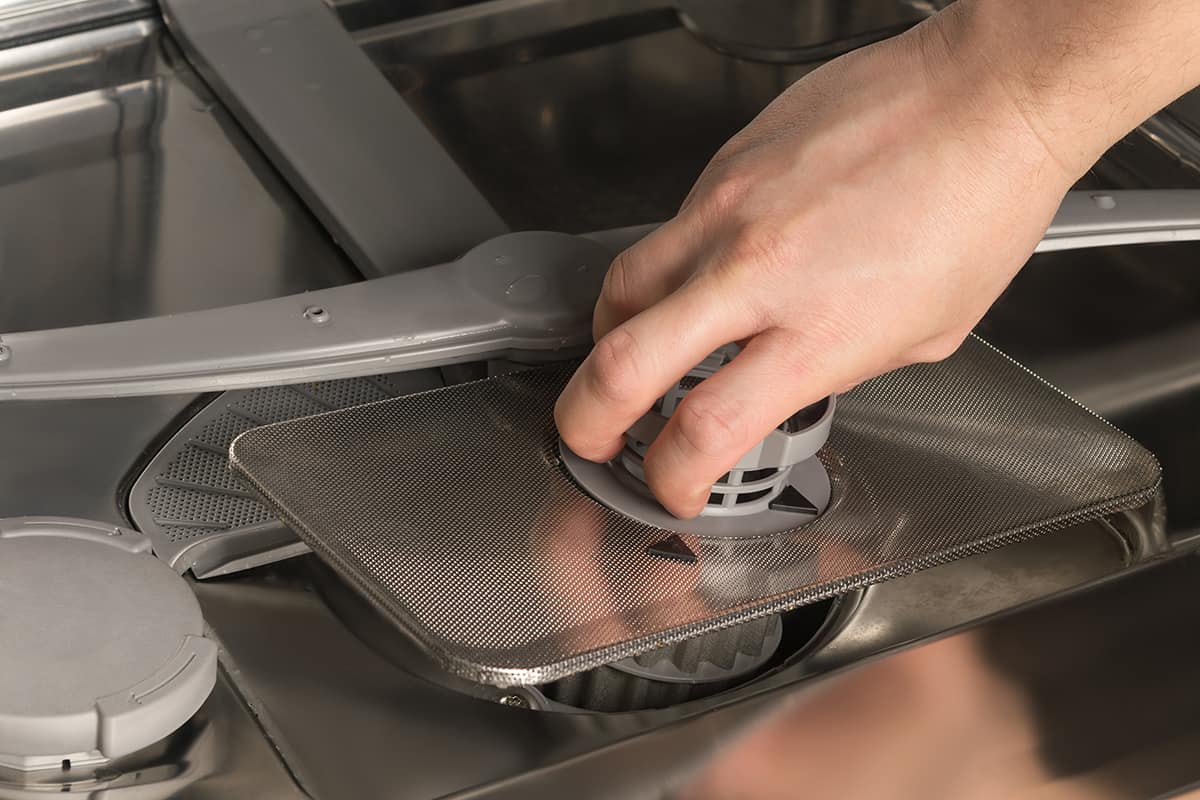Over time, your dishwasher may experience a handful of issues, especially if you don’t take care of it per the manual’s instructions. One common problem people face is standing water in a dishwasher, which can be a direct result of a clogged drain line. Luckily, you can unclog a dishwasher using basic ingredients like baking soda and vinegar.
Here are the steps for unclogging a dishwasher using baking soda:
- Pour 1 cup of baking soda down the dishwasher drain.
- Pour 2 cups of vinegar down the drain.
- Wait for the mixture to stop bubbling.
- Use a bamboo skewer, straightened wire hanger, or a snake plumbing attachment to remove the loosened debris.
- Test the drain line.
However, there are a few things you should do before and after dumping baking soda into your dishwasher. Today, I’ll explain how dishwashers become clogged in the first place, how to unclog a dishwasher with baking soda in greater detail, and how you can prevent your dishwasher from becoming clogged in the future.
How Do Dishwashers Become Clogged?

Many of us probably run dishwashers without giving them a second thought. As long as you’ve loaded the dishracks with dirty plates, the detergent dispenser with detergent, and the rinse aid compartment with rinse aid (did you know dishwashers have rinse aid compartments?), there’s not much else you need to know about dishwashers, right?
That’s not exactly true. As fantastic as dishwashers are at washing dishes, they can be quite cumbersome in terms of maintenance. One of the most annoying things about dishwasher maintenance is getting rid of standing water, which can be a direct result of a clogged drain.
So, how do dishwashers become clogged in the first place?
It really boils down to 1 thing—food soils.
If you read your dishwasher’s paperwork, you’ll most likely find clear instructions on how to load and unload a dishwasher properly. But before all of that, you first have to know how to treat your dirty dishes before stuffing them into the machine.
On the off-chance you forget to scrape off the food soils from your dirty dishes, the soils will fall to the bottom of the tub and gunk up the filter assembly or possibly go down the drain. That’s why you need to, at the very least, remove the largest food remnants from your dishes.
That’s not to say you should pre-rinse them! In fact, pre-rinsing your dishes can “trick” the dishwasher into believing that your dishes aren’t as soiled as they actually are. When this happens, your dishwasher will use less water and detergent to wash your dishes. The result is greasy, slimy dishes that will require a second or even a third wash.
How to Unclog a Dishwasher with Baking Soda
One clearcut sign that your dishwasher’s drain is clogged is standing water. If the water doesn’t flow down the drain as quickly as you’d like, then there’s probably an obstruction in the drain pipe or hose. Luckily, you can resolve this issue using common kitchen ingredients—i.e., baking soda and vinegar.
Below, I’ll provide a step-by-step guide on how to unclog a dishwasher using baking soda. Before we get started, keep the following tools and supplies on hand:
- Bamboo skewer straightened wire hanger, or power cord with snake plumbing attachment
- Rags
- Bucket
- 1 cup of baking soda
- 2 cups of vinegar
Step 1. Preparation
The first thing you need to do is prepare your dishwasher for this deep-cleaning procedure. Here’s a list of things you should do:
Depower the dishwasher (unplug the cord or shut off the circuit).
- Unload the dishracks.
- Remove the bottom dish rack.
- Remove the filter assembly (wash it while you’re at it).
Now, you’re ready to unclog the dishwasher drain.
Step 2. Pour 1 cup of baking soda down the dishwasher drain

Take the 1 cup of baking soda you’ve pre-measured and carefully pour it down the dishwasher drain. As long as most of the baking soda makes its way down the drain, you’ll be fine. You can use a moistened rag to wipe away the baking soda or leave it and let your dishwasher rinse it away during the next wash cycle.
Step 3. Immediately chase the baking soda with 2 cups of vinegar
After dumping the baking soda, quickly but carefully pour 2 cups of vinegar into the drain line. When doing this step, make sure the vinegar doesn’t splash everywhere, especially on the stainless-steel lining of the dishwasher tub.
If the vinegar does spray onto the tub, immediately wipe it away with a moistened rag and dry it with a clean rag. The only type of vinegar you should introduce to stainless steel should be diluted with water (at least a 1:1 mix).
Step 4. Wait for the vinegar-baking soda mixture to stop bubbling
Allow the baking soda and vinegar to react naturally until the mixture stops frothing. You’ll know when you can proceed to the next step when you don’t hear any fizzing noises. This can take anywhere from 30 seconds to 3 minutes, depending on how clogged the drain is.
Step 5. Use the bamboo skewer, straightened wire hanger, or snake plumbing attachment to remove the debris from the dishwasher drain.
A bamboo skewer will only work when the debris is clinging to the opening of the drain. In more severe cases, you’ll need a long, stiff, straight tool to chip away at the debris, such as a straightened wire hanger.
For the most severe cases, you may need to pick up a snake plumbing attachment for your cordless drill. This attachment will aggressively knock loose any clinging debris from the drain line. Just make sure to lower the speed setting of your power drill to reduce damage to the pipe or hose.
Step 6. Test the drain line
You can test the drain line by pouring a bucket of water down the dishwasher drain. If the water drains quickly, you can pack up your supplies and run a test cycle on your dishwasher.
However, if the water doesn’t drain quickly, you’ll need to continue the previous step. In the event your manual or power tools can’t do the job, consider calling a trained plumber to resolve the problem for you.
How to Prevent Dishwasher from Becoming Clogged
After your dishwasher drain has been unclogged, the next thing you should do is ensure it never happens again! Follow these 2 tips to prevent your dishwasher drain from becoming clogged in the future.
Clean the filter assembly regularly.
The filter assembly consists of multiple components or filter tiers. You should remove the solid gunk clinging to the mesh screen regularly to prevent standing water and reduce the risk of clogging.
To clean the filter assembly, remove it from your dishwasher, disassemble the components, and wash them individually in a basin of soapy water. Rinse them and reinstall them in the dishwasher.
It’s generally advised that you clean the filter assembly after each use or at least once a week.
Use your dishwasher frequently.
Not using your dishwasher frequently can allow solid debris in the drain to dry. When this happens, even a hot wash cycle may fail to melt the debris and lead to standing water. So, you should look at your dishwasher’s manual to see how often you should run a wash cycle (usually 5 times a week).






